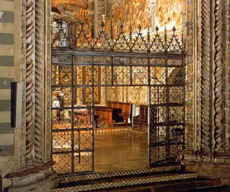index
That iron grill
click on images for full-size:


The iron grill in the Duomo in Orvieto. (The pictured grill is on the right side of the nave, for the chapel containing the famous Signorelli frescoes. It is identical to the grill discussed in the text, which is on the left side of the nave, for the chapel where people pray.)
The iron grill at the Orvieto Duomo decrees a separation; it says that everyday life is going on with its own goals, yet it allows partial transparency. You can see them at their prayers but they are not performing for you. There are multiple forms of life in the place. The streets belong to more than the tourists, and are lived with more than one grammar. Many narratives and many agendas interpenetrate visibly on the public streets. You can see this in the piazza with its mixed uses and discontinuous encounters. The kids doing the passegiata didn't feel on display for the tourists so much as for one another. You can feel the complexity at that grill in the Duomo. The frescos in the adoration chapel are good, but you're not allowed to see them very well. The other end of the transept offers the tourist another chapel where you pay to see the newly restored and more famous Signorelli frescoes. The town takes sustenance from the tourist flow, and works hard to attract it and to stimulate needs for postcards and local-seeming handicrafts, but then the town uses the profits for its own games. The contrast of real versus artificial should be replaced by a contrast between complexity and simplicity. Don't be too quick to condemn a place as superficial; investigate what multiple forms of life are actually present, and the kinds of relations they have to one another. In Orvieto people live the we/they distinction in public. It's not like a theme park. A theme park works on fewer levels that are less visible. Disneyland is more like a machine turned off and serviced at night. In Orvieto the streets at night are lived with more than one grammar. Disney's workers no doubt have their own rituals and local narratives and social dramas, but these are hidden in the underground passages, or enacted unnoticed by the customers when Goofy waves to Mickey. In Orvieto groups perform for one another.